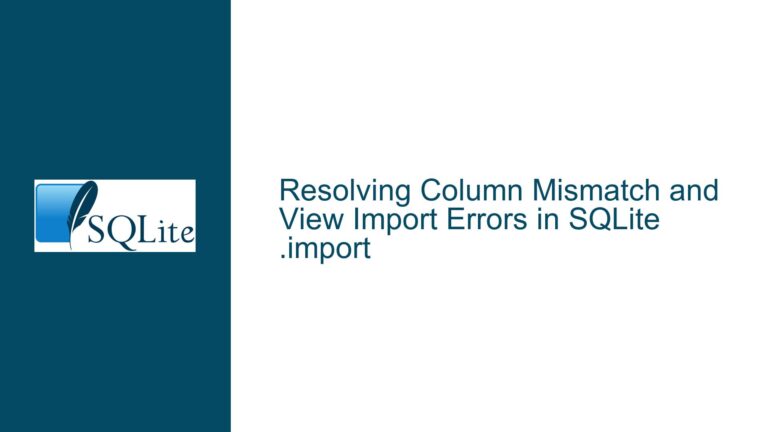Resolving Duplicate Column Renaming Conflicts During CSV Import in SQLite
Column Name Disambiguation Failures in SQLite .import Command
Conflict Between Automatic Renaming and Predefined Column Suffixes
The core issue revolves around SQLite’s .import command failing to handle column name disambiguation when importing CSV files containing duplicate or predefined suffixed column names. This occurs because the algorithm used to rename duplicate columns during CSV import clashes with column names that already contain underscores and numeric suffixes. For example, when a CSV file contains columns named "cat" and "cat_08", the automatic renaming logic may inadvertently create a duplicate "cat_08" column, resulting in an error. The problem is rooted in discrepancies between how the .import command resolves duplicate column names versus other SQLite operations, such as CREATE TABLE AS SELECT.
Discrepancies in Suffix Assignment Logic and Identifier Validity Enforcement
1. Algorithmic Differences Between .import and Schema-Level Renaming
The .import command uses an ordinal position-based suffixing strategy, appending an underscore and the column’s position index to every duplicate column name, including the first occurrence. For instance, if "cow" appears in the 4th and 15th positions, they are renamed to "cow_04" and "cow_15". This contrasts with SQLite’s general schema-level renaming, which appends a colon and a sequential count to duplicates after the first occurrence (e.g., "cat:1" for the second "cat" column). The .import logic prioritizes positional indexing to avoid reliance on runtime name tracking but introduces conflicts when existing column names already contain underscores and numbers.
2. Invalid Identifier Handling During Name Mangling
SQLite enforces identifier validity rules for column names (e.g., alphanumeric characters and underscores). The .import command attempts to create valid identifiers by using underscores for disambiguation. However, if the original column name contains invalid characters or underscores followed by numbers (e.g., "cat_08"), the renaming process may generate conflicting names. For example, a duplicate "cat" column in position 8 would be renamed to "cat_08", colliding with an existing "cat_08" column. This violates uniqueness constraints because the disambiguation logic does not account for preexisting suffixes.
3. Ambiguity in Suffix Interpretation
The ordinal position-based suffixing assumes that column names do not contain underscores with numeric suffixes. When they do, the algorithm cannot distinguish between user-defined suffixes (e.g., "cat_08") and system-generated ones (e.g., "cat_08" from the 8th column). This leads to false duplicates, as seen in the error duplicate column name: cat_08, where both a user-provided and system-generated column share the same name.
Schema Validation, CSV Preprocessing, and Algorithm Overrides
Step 1: Validate CSV Headers Before Import
Use a script or tool to scan the CSV header for names containing underscores followed by numbers. For example, detect patterns like /[a-zA-Z]+_\d+/ using regex. If such columns exist, rename them proactively to avoid conflicts. For instance, change "cat_08" to "cat_orig_08" before importing. Tools like sed or Python’s pandas library can automate this:
import pandas as pd
df = pd.read_csv('farm.csv', nrows=0)
new_columns = []
for col in df.columns:
if '_' in col and col.split('_')[-1].isdigit():
col = f"{col}_orig"
new_columns.append(col)
df.columns = new_columns
df.to_csv('farm_modified.csv', index=False)
Step 2: Define an Explicit Schema to Bypass Automatic Renaming
Create a table with predefined column names before importing, which forces the .import command to map CSV data to the schema without renaming. For example:
CREATE TABLE farm_data (
hippopotamus_01 INTEGER,
pig_02 INTEGER,
aligator INTEGER,
cow_04 INTEGER,
cat_05 INTEGER,
turkey INTEGER,
duck INTEGER,
cat_08 INTEGER,
hippopotamus_09 INTEGER,
horse INTEGER,
cat_08_orig INTEGER, -- Renamed from original "cat_08"
sheep INTEGER,
goat INTEGER,
pig_14 INTEGER,
cow_15 INTEGER
);
.import --csv farm.csv farm_data
This ensures that column names are explicitly controlled, avoiding algorithmic conflicts.
Step 3: Modify the .import Command’s Disambiguation Logic
For advanced users, customize SQLite’s shell code to alter the renaming algorithm. The sqlite3 shell’s source file shell.c contains the resolveDuplicateColumnNames function. Modify the suffix generation to use a non-conflicting pattern, such as double underscores or a prefix:
// Original code snippet (simplified)
for(i=0; i<nCol; i++){
if( aColUsed[i] ){
int cnt = 0;
for(j=0; j<nCol; j++){
if( j==i ) continue;
if( sqlite3_stricmp(azCol[i], azCol[j])==0 ) cnt++;
}
if( cnt>0 ){
sqlite3_snprintf(nCol, &azCol[i], "%s_%02d", azCol[i], i+1);
}
}
}
// Modified code: Use a prefix instead of a suffix
if( cnt>0 ){
sqlite3_snprintf(nCol, &azCol[i], "col_%02d_%s", i+1, azCol[i]);
}
Recompile SQLite after making this change. Note that this requires technical expertise and is not recommended for most users.
Step 4: Use Temporary Tables for Intermediate Renaming
Import the CSV into a temporary table with automatic renaming, then copy the data into a final table with manually adjusted names:
.import --csv farm.csv temp_farm_data
CREATE TABLE final_farm_data AS
SELECT
hippopotamus_01 AS hippopotamus,
pig_02 AS pig,
aligator,
cow_04 AS cow,
cat_05 AS cat,
turkey,
duck,
cat_08 AS cat_duplicate,
hippopotamus_09 AS hippopotamus_secondary,
horse,
cat_08_orig,
sheep,
goat,
pig_14 AS pig_secondary,
cow_15 AS cow_secondary
FROM temp_farm_data;
Step 5: Adjust SQLite Configuration for Identifier Relaxation
SQLite can be configured to relax identifier naming rules via compile-time options, but this does not resolve the duplicate name issue. Instead, use quoted identifiers to handle columns with numeric suffixes:
CREATE TABLE "farm_data" (
"hippopotamus" INTEGER,
"pig" INTEGER,
"aligator" INTEGER,
"cow" INTEGER,
"cat" INTEGER,
"turkey" INTEGER,
"duck" INTEGER,
"cat:1" INTEGER, -- Use colon suffix explicitly
"hippopotamus:1" INTEGER,
"horse" INTEGER,
"cat_08" INTEGER,
"sheep" INTEGER,
"goat" INTEGER,
"pig:1" INTEGER,
"cow:1" INTEGER
);
This approach mirrors SQLite’s schema-level renaming but requires manual effort.
Step 6: Utilize External Tools for CSV Import
Avoid SQLite’s .import command entirely by using tools like sqlite-utils (Python) or CSVKit, which offer more control over column renaming:
csvsql --db sqlite:///farm.db --tables farm_data --insert farm.csv
from sqlite_utils import Database
import pandas as pd
db = Database("farm.db")
df = pd.read_csv("farm.csv")
# Rename columns programmatically
df.columns = [f"{col}_{idx}" if df.columns[:idx].tolist().count(col) > 0 else col
for idx, col in enumerate(df.columns, 1)]
db["farm_data"].insert_all(df.to_dict(orient="records"))
By addressing the algorithmic mismatch, preprocessing CSV headers, and leveraging schema definitions or external tools, users can resolve column name conflicts during CSV import. The key is to either adapt the input data to SQLite’s renaming conventions or override the default behavior through explicit schema control or code modifications.





